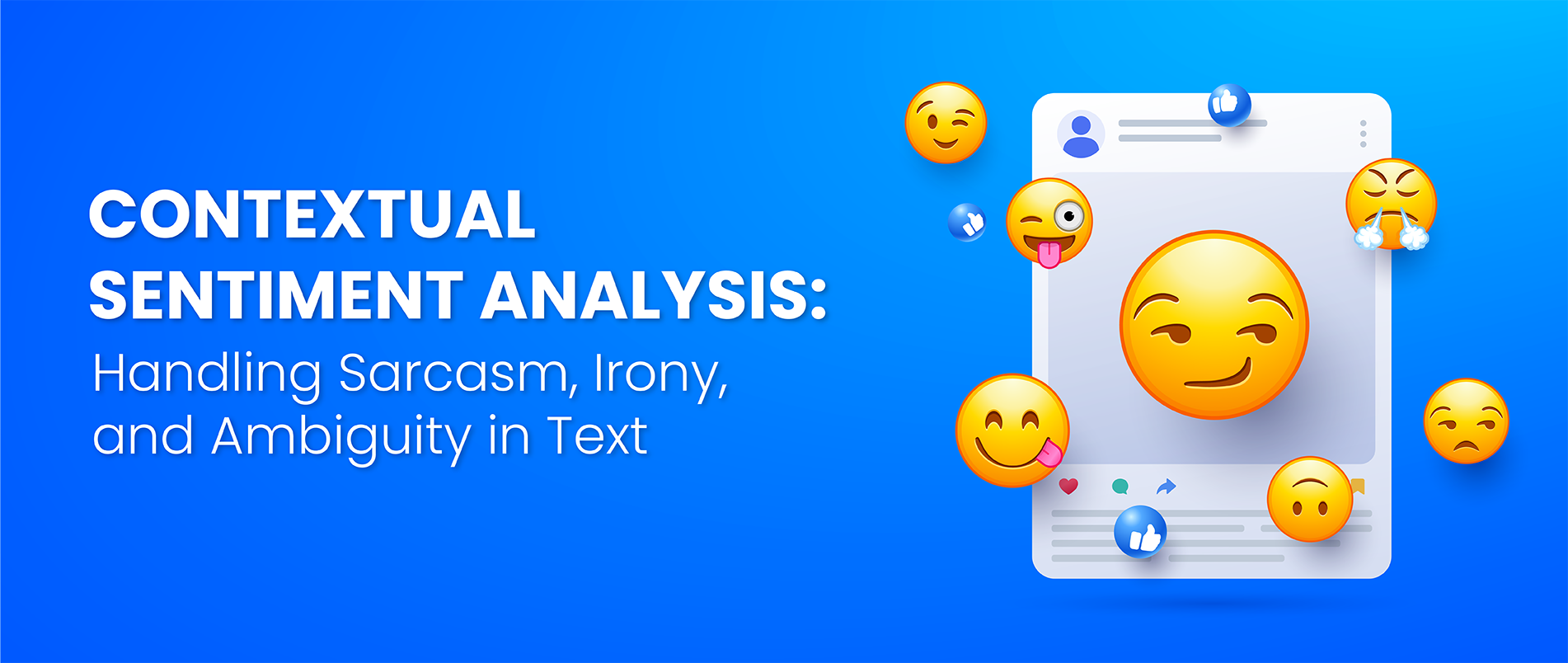Sentiment analysis is transforming how businesses interpret customer emotions in text, offering invaluable insights from customer reviews, social media posts, and online conversations. However, while simple positive and negative statements are easy to analyse, the real challenge begins when sarcasm, irony, and ambiguity come into play.
For example, if someone says:
"She was really salty after the game."
A Millennial might assume it refers to sweating and exhaustion, while a Gen Z would likely interpret it as bitterness or jealousy over losing.
This is where contextual sentiment analysis comes in.
Contextual Sentiment Analysis: Why Context Matters
Unlike traditional sentiment analysis, which simply classifies words as positive, negative, or neutral, contextual sentiment analysis understands how the meaning of words changes based on context. Context-aware models use background knowledge, sentence structure, and linguistic cues to distinguish between literal and implied meanings. This makes them far superior in analysing customer sentiments, brand reputation, and social media trends. And that's exactly why businesses are abuzz about this!
Detecting Sarcasm, Irony, and Ambiguity in Text: NLP Then vs Now
While NLP has evolved significantly, improving models through rule-based, machine learning, and deep-learning approaches, handling sarcasm, irony, and ambiguity remains a challenge. This article is an attempt to show how traditional models detect these complexities in text and where modern transformer-based models outperform them.
Sarcasm Detection
Sarcasm is a mocking or exaggerated statement, often appearing positive in words but conveying a negative or opposite sentiment.
None can beat Chandler Bing when it comes to sarcasm. Are you with me on this? Here's one from Friends that still cracks me up to this day!

"Oh, what did the police say?" (Source: Pinterest)
Can a Bidirectional Long Short-Term Memory Network (BiLSTM model), which is said to be context-aware, successfully detect Chandler's sarcasm? Let's put it to the test.
What the Model Will Do
Before we dive into the code, here's a quick look at what's going on behind the scenes:
- We'll train a Bidirectional LSTM model that processes headlines both forward and backward — a big plus when dealing with sarcasm, which can appear anywhere in a sentence.
- The training will run for 5 epochs, just enough for the model to learn patterns without overfitting or dragging the process.
- We'll use a batch size of 32, striking a balance between speed and training stability.
- Word embeddings will turn each word into a 128-dimensional vector, helping the model understand context beyond just word order.
- Dropout layers will randomly deactivate parts of the model during training to prevent it from relying too much on specific patterns. This improves generalisation.
- Finally, the output layer will give us a sarcasm probability score between 0 and 1. Anything above 0.5 will be flagged as sarcastic.
We are all set! Let's get into the code.
Just make sure you've uploaded Sarcasm_Headlines_Dataset.json to your files. You'll find it on Kaggle.
import numpy as np
import pandas as pd
import sys
import os
try:
import tensorflow as tf
from tensorflow.keras.preprocessing.text import Tokenizer
from tensorflow.keras.preprocessing.sequence import pad_sequences
from tensorflow.keras.models import Sequential
from tensorflow.keras.layers import Embedding, Bidirectional, LSTM, Dense, Dropout
except ModuleNotFoundError:
print("Warning: TensorFlow is not installed or not available in this environment. The script will proceed without model training.")
tf = None
from sklearn.model_selection import train_test_split
from sklearn.metrics import accuracy_score
data_file = "/content/Sarcasm_Headlines_Dataset.json"
if not os.path.exists(data_file):
print(f"Warning: The dataset file", data_file, "does not exist. Please upload it to the working directory.")
df = None
else:
df = pd.read_json(data_file, lines=True)
if df is not None:
# Extract text and labels
texts = df['headline'].values
labels = df['is_sarcastic'].values
# Tokenization & Padding
max_vocab_size = 10000
max_length = 50
embedding_dim = 128
tokenizer = Tokenizer(num_words=max_vocab_size, oov_token="")
tokenizer.fit_on_texts(texts)
sequences = tokenizer.texts_to_sequences(texts)
padded_sequences = pad_sequences(sequences, maxlen=max_length, padding='post', truncating='post')
# Split data
X_train, X_test, y_train, y_test = train_test_split(padded_sequences, labels, test_size=0.2, random_state=42)
if tf:
# Build BiLSTM model
model = Sequential([
Embedding(max_vocab_size, embedding_dim, input_length=max_length),
Bidirectional(LSTM(64, return_sequences=True)),
Dropout(0.3),
Bidirectional(LSTM(64)),
Dense(64, activation='relu'),
Dropout(0.3),
Dense(1, activation='sigmoid')
])
# Compile the model
model.compile(loss='binary_crossentropy', optimizer='adam', metrics=['accuracy'])
# Train the model
model.fit(X_train, y_train, epochs=5, batch_size=32, validation_data=(X_test, y_test))
# Evaluate the model
predictions = (model.predict(X_test) > 0.5).astype("int32")
accuracy = accuracy_score(y_test, predictions)
print(f"Test Accuracy: {accuracy:.4f}")
# Function for sarcasm prediction
def predict_sarcasm(text):
seq = tokenizer.texts_to_sequences([text])
padded = pad_sequences(seq, maxlen=max_length, padding='post', truncating='post')
prediction = model.predict(padded)[0][0]
return "Sarcastic" if prediction > 0.5 else "Not Sarcastic"
# Example usage
example_texts = ["Someone at work ate my sandwich. Oh, what did the police say?"]
for text in example_texts:
print(f"Input: {text} -> Prediction: {predict_sarcasm(text)}")
else:
print("Skipping model training and prediction as TensorFlow is not available.")
else:
print("Skipping dataset processing as the file is missing.")
Expected Output

BiLSTM, despite being more advanced than traditional models, still struggles with sarcasm detection due to its inherent limitations in contextual understanding. Without an attention mechanism, it does not effectively highlight the contradiction between frustration and exaggerated seriousness, which is key to sarcasm. Moreover, since BiLSTM processes text sequentially, it cannot fully capture sentence-wide relationships the way Transformer-based models like RoBERTa do.
Irony Detection
Irony occurs when words convey the opposite of their literal meaning, often relying on contrast and contradiction within the statement. This subtlety makes it difficult for machines to interpret irony correctly, as they often miss the hidden contrast in the sentiment.
For instance, take this well-known line from Monsters, Inc.
"Your stunned silence is very reassuring".
The line's implied scepticism makes it a clear example of irony. Let's try this if a pre-trained transformer model detects it effectively.
Using RoBERTa for Irony Detection
from transformers import pipeline
# Load pre-trained irony detection model
irony_detector = pipeline("text-classification", model="cardiffnlp/twitter-roberta-base-irony")
# Monsters, Inc. ironic sentence
text = "Your stunned silence is very reassuring."
result = irony_detector(text)
# Print result
print(f"Irony Score: {result[0]['score']:.4f}")
Expected Output

An irony score of ~0.98 says it all about transformer-based models.
Let's step up our game a bit this time.
Ambiguity Detection
Ambiguous sentences often carry multiple meanings, making them difficult for machines to interpret without context. One widely used rule-based approach is Word Sense Disambiguation (WSD), which determines the proper meaning of a word, taking into account its context within a sentence.
For instance, this dialogue from The Godfather serves as a classic:

"I'm gonna make him an offer he can't refuse."(Source: Magicalquote.com)
While there are various types of ambiguity, this statement is an example of pragmatic ambiguity, in which the meaning of a sentence depends on context or external knowledge rather than just the words themselves.
Depending on context, this phrase could mean:
A great business deal (literally).
A subtle threat (contextually).
Let's check if the Lesk Algorithm for Word Sense Disambiguation can resolve this ambiguity.
# Import necessary NLTK libraries
import nltk
from nltk.wsd import lesk
from nltk.tokenize import word_tokenize
# Download necessary datasets (run this only once)
nltk.download('wordnet')
nltk.download('punkt_tab')
nltk.download('omw-1.4')
# Define a sentence with an ambiguous word
sentence = "I'm gonna make him an offer he can't refuse."
word = "offer"
print(word_tokenize(sentence))
# Apply Lesk Algorithm for Word Sense Disambiguation
sense = lesk(word_tokenize(sentence), word)
# Print the output
print(f"Word: {word}")
if sense:
print(f"Disambiguated Meaning: {sense.definition()}")
else:
print("No suitable meaning found.")
Expected Output

So, how does it work? Lesk Algorithm identifies the most contextually relevant meaning of “offer”. However, it may not capture deeper implied threats—hence, transformers are often preferred for complex ambiguity resolution.
Transformer-based models, particularly those like BERT, RoBERTa, and GPT, are excellent at understanding contextual meaning; however, pragmatic ambiguity — which depends on real-world knowledge, speaker intent, and situational awareness—remains a challenge. But the good thing about Transformers is that their working arena is wide open! Perhaps a fine-tuned model on movie dialogues is more likely to detect the pragmatic ambiguity correctly.
Alternative Approaches for Contextual Analysis
While early NLP relied heavily on rule-based methods, deep learning models like LSTMs and GRUs introduced context awareness before Transformers. However, they struggled with long-range dependencies, which Transformers effectively solved—making them the dominant choice for modern NLP.
Although transformers and attention mechanisms lead the way, other methods still play a role. Lexicon-based approaches rely on predefined sentiment word lists, which are useful for basic sentiment tracking but ineffective for sarcasm. Hybrid models, blending rule-based and machine-learning techniques, offer a more balanced approach. Meanwhile, semi-automated NLP methods assist in customer service, flagging ambiguous or sarcastic messages for human review to prevent misinterpretation.
What’s Reserved for the Future?
The future of sentiment analysis lies in multimodal AI, integrating text, voice, and facial expressions for deeper emotional insights. Real-time learning models will adapt to evolving slang and memes, while Emotion AI aims to make chatbots more human-like, enhancing interactions with context-aware empathy.
Despite these advancements, can AI ever truly master sarcasm, irony, and ambiguity with the same wit as humans? Perhaps one day! Don’t you think? Drop your thoughts below!





.jpg)




